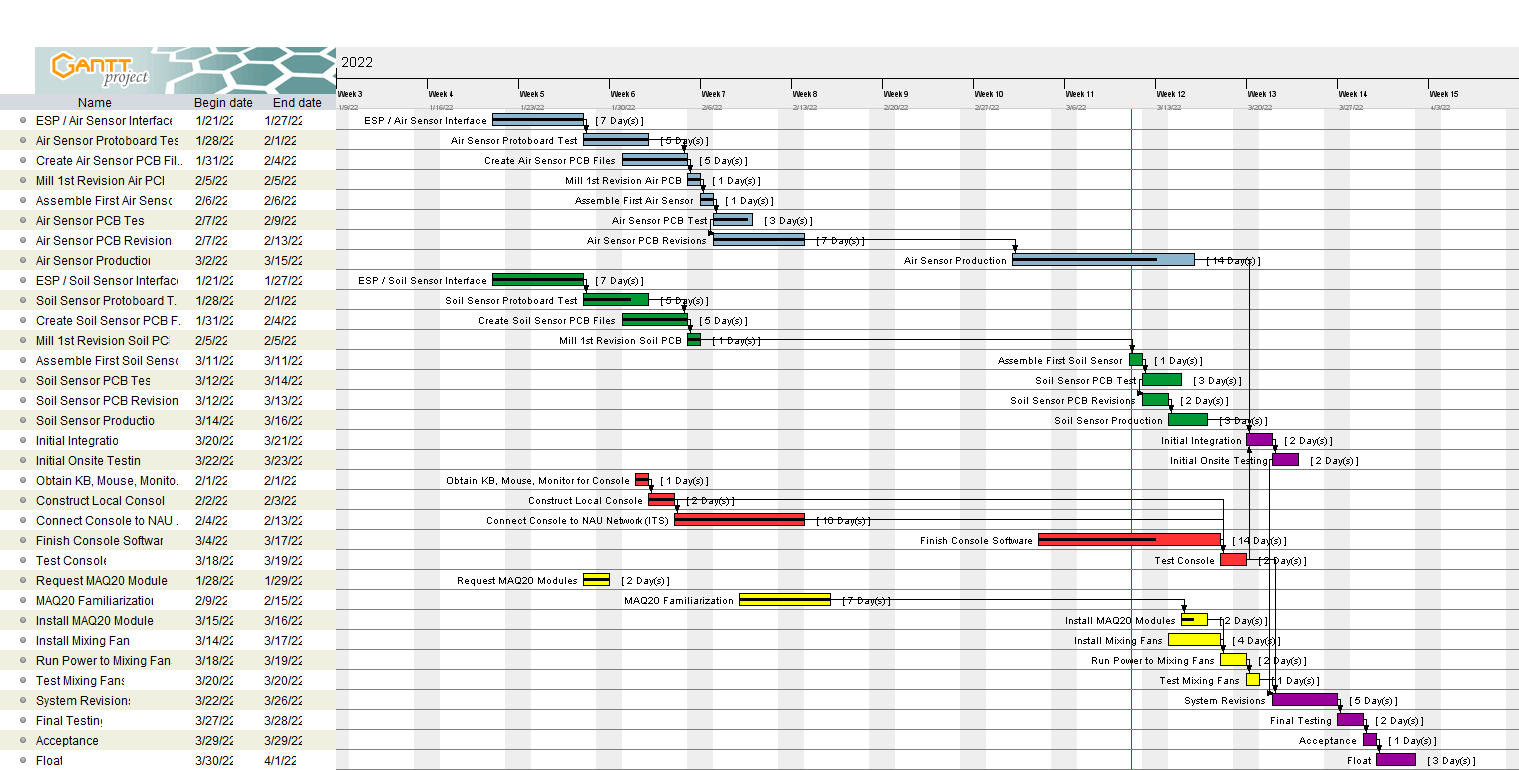
Gantt chart showing project tasks and progress for Spring 2022. Current 3/11/2022.
During the spring semester, the team has quite a bit to accomplish. The Gantt chart is a scheduling tool used to visualize the time and dependency relationships between the many tasks involved in completing a project of this size.
Tasks are shown in the chart as colored bars. For this project, tasks related to power or control are colored yellow, air sensor tasks are light blue, soil sensor tasks are green, and whole-project/integration tasks are purple. The length of each bar corresponds to that task's estimated duration. A black bar in the middle of a task indicates the degree to which that task has been completed.
Dependency relationships between tasks are shown by thin arrows linking dependent tasks. For example, the arrow between the second and third tasks in the chart shows that the interface between the ESP8266 microcontroller and the DHT22 air sensor must be completed before beginning to test the air sensor module on a breadboard (a finish-to-start relationship). Other relationships are possible, such as finish-to-finish or start-to-finish. An arrow extending horizontally indicates either float time between tasks, or a required delay in that dependency. The cross hatching on some tasks indicates that they are on the "critical path" where any delay in such tasks will delay project completion.
All project work, including testing and revisions, is required to be completed by April 1, 2022. Note the "Float" pseudo-task at the bottom of the chart, set to end on April 1. This shows that given our estimates of the time required for each task in the chart, there are only three extra days in the semester to contend with unexpected delays. This small amount of float time makes success a challenge, but not impossible.

Gantt chart showing project tasks and progress for Spring 2022. Current 3/11/2022.
Many tasks on the project have taken longer than expected, and much work remains to be done in the next three weeks. Our projected float has shrunk to three days from a peak expectation of 10 days. The university break, March 14-18, will be spent making up for delays and completing fabrication and installation tasks. As of this writing, the air sensor modules are electrically complete, but still need to be packaged. The soil sensors need to be fabricated and tested. The MAQ20 control equipment is functional, and packaging is expected to be complete today. Installation should take place next week.
A system of this complexity will require testing at many levels to ensure that all components operate correctly, both individually and in connection with each other. A master testing table has been developed to guide testing operations. Because of the number of requirements for this project, the table is very large. As such, it can be viewed here rather than inline.
Some example tests are called out in the diagram below:
The four marked tests are intended to verify the most important function of the system: frequent acquisition of accurate temperature and humidity data, and prompt SMS reporting of unsafe conditions. Tests 1 and 2 will be conducted by placing an air sensor in humidity- and temperature-controlled environments, then comparing to a known accurate sensor. Test 3 involves allowing a sensor to run unattended for a period of several hours, then checking the database logs to ensure that data was received and stored at the appropriate rate. Finally, the Live Alert test will be conducted by placing a sensor in a cold environment, such as a refrigerator, and verifying that an SMS alert is received within the prescribed five-minute period.
Due to project delays, the soil moisture sensor was not completed by the end of the semester. The remainder of the project is substantially functional. Final delivery and client training will be taking place this week. Perhaps the biggest lesson here is to keep project goals realistic and to not get overconfident with respect to a team's ability to handle a complex project. This project was far more complex than was originally anticipated which led to a range of issues and delays throughout the year.
Designed with Mobirise web template